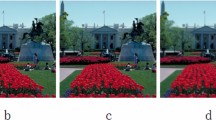Abstract
In this work, deep learning for enhancing the sharpness of blurred image is investigated. Initial pre-processing is blur image kernel estimation which is critical for blind image de-blurring. In prior investigation, handcrafted blur features are optimized for certain uniform blur, which is unrealistic for blind de-convolution. To deal with this crisis, initially this work attempts to carry out kernel matrix estimation using latent semantic analysis (KME-LSA) in dermatology image. In order to enhance the image sparseness, this work modelled an image descriptor based on Gaussian mixture model in auto-encoder (GMM-AE) as a primary layer in convolutional neural networks. The functionality of the proposed GMM-AE triggers the selection of efficient features for subsequent layers in CNN. The features extracted from the integrated trained GMM-AE in CNN can fine-tune the quality of blurred image. Datasets used are melanoma-based dermascope images. Pre-processing procedures are carried out by LSA-based kernel matrix estimation. The attained sharp image outcome is given to the proposed model for effective feature extraction and to attain improved blind image. The anticipated KME-LSA and GMM-AE in CNN estimates blur parameters with high accuracy. Experiment illustrates the efficacy of proposed method and the competitive outcomes are compared with state-of-the-art datasets. Simulation was carried out in MATLAB environment; performance metrics like MSE—227.6, PSNR—33.6762, SSIM—0.9755 and VIF—0.08162 are evaluated. The results show better trade-off than the prevailing techniques.











Similar content being viewed by others
References
Almeida M, Almeida L (2010) Blind and semi-blind de-blurring of natural images. IEEE Trans Image Process 19(1):36–52
Cho S, Wang J, Lee S (2011) Handling outliers in non-blind image de convolution. In: 2011 IEEE conference on ICCV, pp 495–502
Chrysos GG, Zafeiriou S (2019) Deep face deblurring. In: IEEE conference on computer vision and pattern recognition workshops CVPRW
De Vylder J (2016) Image restoration using deep learning. In: Proceedings of Benelearn
Dong W (2018) Denoising prior driven deep neural network for image restoration
Ellappan V, Chopra V (2017) Reconstruction of noisy and blurred images using blur kernel. IOP Conf Ser Mater Sci Eng 263:042024
Fei X (2017) Deblurring adaptive optics retinal images using deep convolution neural networks. Biomed Opt Express 8(12):5675–5687
Gong D, Tan M, Zhang Y, van den Hengel A, Shi Q (2017) Self placed kernel estimation for robust blind image deblurring. In: IEEE International Conference on Computer Vision (ICCV)
Huang P-H (2008) Image de-blurring with blur kernel estimation from a reference image patch. IEEE, Washington
Huang H-Y (2014) Blurred image restoration using fast blur-kernel estimation. In: Tenth international conference on intelligent information hiding and multimedia signal processing. IEEE
Kim N, Heo M (2016) Two step Gaussian mixture model approach to characterize white matter disease based on distributional changes. J Neurosci Methods 270:156–164
Krishnan D, Tay T, Fergus R (2011) Blind deconvolution using a normalized sparsity measure. IEEE, pp 233–240
Lo Conti F (2017) A regularized deep learning approach for image de-blurring. ACM, New York
Nazare TS (2016) Deep convolutional neural networks and noisy images research gate
Pham T-T (2017) Latent semantic fusion model for image retrieval and annotation. In: CIKM’07. ACM
Praks P (2016) Latent semantic indexing for image retrieval systems. Latent Semantic Indexing for Image Retrieval Systems. https://www.semanticscholar.org
Prasada Kumari KS (2016) Self-adaptive image processing using blind image quality assessment technique. Perspect Sci 8:639–641
Rouf M (2015) A study on blur kernel estimation from blurred and noisy image pairs. CPSC 548 Direct Graduate Studies course report
Schuler CJ (2014) Learning to deblur
Sun L, Cho S, Wang J, Hays J (2013) Edge-based blur kernel estimation using patch prior. In: IEEE International conference on computational photography, Cambridge, MA, USA
Yang J (2013) Face recognition based on image latent semantic analysis model and SVM. Int J Signal Process Image Process Pattern Recognit 6(3):105–107
Yang X (2016) Blind image quality assessment via probabilistic latent semantic analysis. Springer Plus 5(1):1714
Yuan Y, Mou L, Lu X (2015) Scene recognition by manifold regularized deep learning architecture. IEEE Trans Neural Netw Learn Syst 26:2222–2233
Zhai S, Cheng Y, Lu W, Zhang Z (2016) Deep structured energy based models for anomaly detection. In: International conference on machine learning, pp 1100–1109
Zhou C, Paffenroth RC (2017) Anomaly detection with robust deep auto encoders. In: Proceedings of the 23rd ACM SIGKDD international conference on knowledge discovery and data mining, pp 665–674
Author information
Authors and Affiliations
Corresponding author
Ethics declarations
Conflict of interest
We do not have any conflict of interest.
Additional information
Communicated by V. Loia.
Publisher's Note
Springer Nature remains neutral with regard to jurisdictional claims in published maps and institutional affiliations.
Rights and permissions
About this article
Cite this article
Gowthami, S., Harikumar, R. Conventional neural network for blind image blur correction using latent semantics. Soft Comput 24, 15223–15237 (2020). https://doi.org/10.1007/s00500-020-04859-y
Published:
Issue Date:
DOI: https://doi.org/10.1007/s00500-020-04859-y




